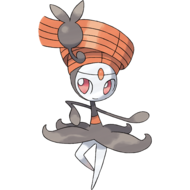From Bulbapedia, the community-driven Pokémon encyclopedia.
|
|
|
|
Types
|
Aria Forme
|
Pirouette Forme
|
|
|
|
|
|
|
|
|
|
|
|
|
|
|
|
|
Height
2'00"
Imperial
|
0.6 m
Metric
|
2'00"/0.6 m
Aria Forme
|
0'0"/0.0 m
Pirouette Forme
|
0'0"/0.0 m
|
|
|
Weight
14.3 lbs.
Imperial
|
6.5 kg
Metric
|
14.3 lbs./6.5 kg
Aria Forme
|
0.0 lbs./0.0 kg
Pirouette Forme
|
0.0 lbs./0.0 kg
|
|
|
|
|
|
|
|
|
|
|
|
|
EV yield
HP
0
|
Atk
1
|
Def
1
|
Sp.Atk
0
|
Sp.Def
0
|
Speed
1
|
| Base Exp.: 270
|
Battle Exp.: 2701*
|
|
|
|
|
Meloetta (Japanese: メロエッタ Meloetta) is a Normal-type legendary Pokémon.
While it is not known to evolve into or from any Pokémon, it has a second Forme activated by using the move Relic Song in battle. Its original Forme, Aria Forme, will then become Pirouette Forme.
Meloetta was leaked on a poster of M15 on February 26, 2012, and it was officially revealed by Oha Suta on March 1, 2012.
Biology
Physiology
Meloetta seems to be a femininely anthropomorphic figure with musical bar-style streaks in its hair, quarter notes (♩) for its arms and hands, and pupil-less eyes resembling whole notes. It has a third eye or a jewel on its forehead and a black headpiece that seems to be shaped like a treble clef which doubles as an attached microphone such as one often used by singers. Its ovular head seems to be ⅓ its body's height and about half its height in width. In its Aria Forme, it has light blue eyes and flowing, wavy hair with light-blue ovals that resemble whole notes. In its Pirouette Forme, it has auburn hair that seems to be stylized in a high bun and red eyes. In either Forme, its midriff and eyes match its hair.
Gender differences
Meloetta is a genderless species.
Special abilities
According to artists in Unova, Meloetta's beautiful music and dance inspired many works of art, music, and songs. This made the Pokémon popular among both musicians and dancers.
Meloetta is able to change forms when it uses the move Relic Song, which changes its form from Aria Forme to its Pirouette Forme, or vice versa. In its Aria Forme, it is a dual-type Normal/Psychic-type Pokémon; in its Pirouette Forme, it is a dual-type Normal/Fighting-type Pokémon. It reverts to Aria Forme when switched out or when the battle ends. Like many other legendary Pokémon, Meloetta is capable of becoming invisible.
Behavior
In its Aria Forme, Meloetta can sing beautiful songs. While in its Pirouette Forme, Meloetta can perform graceful dances.
Habitat
Diet
- Main article: Pokémon food
History
Meloetta once played a song and danced so lightly, it filled people's hearts with joy. However, when sorrow darkened the world, Meloetta lost the melody. At the same time, its red shoes were lost somewhere.
Upon entering the cafe in Castelia City, a guitarist, who knows of the story, remembers Meloetta's melody. Upon playing it, Meloetta remembers the song that it had danced to.
In the anime

Meloetta's Pirouette Forme in the anime
Major appearances
Meloetta made its debut in An Epic Defense Force!.
Minor appearances
In the TCG
- Main article: Meloetta (TCG)
Game data
Pokédex entries
| This Pokémon was unavailable prior to Generation V.
|
|
|
|
|
|
|
|
|
| Generation V
|
|
| Black
|
Its melodies are sung with a special vocalization method that can control the feelings of those who hear it.
|
| White
|
Many famous songs have been inspired by the melodies that Meloetta plays.
|
| Black 2
|
The melodies sung by Meloetta have the power to make Pokémon that hear them happy or sad.
|
| White 2
|
{{{white2dex}}}
|
|
|
|
|
Game locations
| This Pokémon was unavailable prior to Generation V.
|
|
|
|
|
|
|
|
|
|
|
|
|
In side games
In events
| Games
|
Event
|
Language
|
Location
|
Level
|
Distribution period
|
|
|
Movie Meloetta
|
Japanese
|
Japan and Taiwan
|
15
|
July 14 to September 30, 2012; October 5, 2012
|
|
|
Movie Meloetta
|
Korean
|
South Korea
|
15
|
December 19, 2012 to February 28, 2013
|
|
|
Spring 2013 Meloetta
|
English
|
Europe, the Americas, and Australia
|
50
|
February 23 to April 19, 2013
|
|
|
Spring 2013 Meloetta
|
French
|
Europe
|
50
|
March 4 to April 19, 2013
|
|
|
Spring 2013 Meloetta
|
German
|
Europe
|
50
|
March 22 to April 19, 2013
|
|
|
Spring 2013 Meloetta
|
Italian
|
Europe
|
50
|
March 22 to April 19, 2013
|
|
|
Spring 2013 Meloetta
|
Spanish
|
Europe
|
50
|
March 22 to April 19, 2013
|
Held items
Base stats
|
Aria Forme
|
| Stat
|
Range
|
| At Lv. 50
|
At Lv. 100
|
100
|
|
160 - 207
|
310 - 404
|
77
|
|
73 - 141
|
143 - 278
|
77
|
|
73 - 141
|
143 - 278
|
128
|
|
119 - 198
|
234 - 390
|
128
|
|
119 - 198
|
234 - 390
|
90
|
|
85 - 156
|
166 - 306
|
Total: 600
|
Other Pokémon with this total
|
- Minimum stats are calculated with 0 EVs, IVs of 0, and (if applicable) a hindering nature.
- Maximum stats are calculated with 252 EVs, IVs of 31, and (if applicable) a helpful nature.
|
|
Pirouette Forme
|
| Stat
|
Range
|
| At Lv. 50
|
At Lv. 100
|
100
|
|
160 - 207
|
310 - 404
|
128
|
|
119 - 198
|
234 - 390
|
90
|
|
85 - 156
|
166 - 306
|
77
|
|
73 - 141
|
143 - 278
|
77
|
|
73 - 141
|
143 - 278
|
128
|
|
119 - 198
|
234 - 390
|
Total: 600
|
Other Pokémon with this total
|
- Minimum stats are calculated with 0 EVs, IVs of 0, and (if applicable) a hindering nature.
- Maximum stats are calculated with 252 EVs, IVs of 31, and (if applicable) a helpful nature.
|
|
Type effectiveness
|
Aria Forme
|
| Under normal battle conditions in Generation V, this Pokémon is:
|
|
|
|
|
|
|
|
|
|
|
|
|
|
Pirouette Forme
|
| Under normal battle conditions in Generation V, this Pokémon is:
|
|
|
|
|
|
|
|
|
|
|
|
|
|
Learnset
|
|
|
|
- Bold indicates a move that gets STAB when used by Meloetta
- Italic indicates a move that gets STAB only when used by an Evolution or alternate form of Meloetta
- Click on the generation numbers at the top to see level-up moves from other generations
|
|
|
| Father |
Move |
Type |
Cat. |
Pwr. |
Acc. |
PP
|
| This Pokémon learns no moves by breeding.
|
- Moves marked with an asterisk (*) must be chain bred onto Meloetta in Generation V
- Moves marked with a double dagger (‡) can only be bred from a Pokémon who learned the move in an earlier generation.
- Moves marked with a superscript game abbreviation can only be bred onto Meloetta in that game.
- Bold indicates a move that gets STAB when used by Meloetta
- Italic indicates a move that gets STAB only when used by an Evolution of Meloetta
|
Side game data
Evolution
Sprites
Trivia
Origin
Meloetta's Aria Forme resembles a typical singer with the black headpiece acting like a headset microphone, while the Pirouette Forme resembles a ballerina wearing a tutu and its "hair" curled up in a bun. In this Forme it also shares elements from Spanish Flamenco dancers. Meloetta's headpiece resembles a stylized treble clef. It may be also based on a muse, a mythological entity to whom was attributed, in Ancient Greece, the ability to inspire artistic creation.
Name origin
Meloetta may be a combination of melody and pirouette (a type of movement in ballet). Etta is also a common, feminine Italian suffix meaning little and may refer to Meloetta's feminine appearance and diminutive size. It may literally mean little melody, as Italian words are commonly used for musical directions and descriptions. Etta could also have derived from the famous jazz singer Etta James.
Aria is a term now used almost exclusively to describe a self-contained piece for one voice usually with orchestral accompaniment, and is commonly used in opera.
Pirouette—French for to whirl—is a controlled turn on one leg, starting with one or both legs in plié and rising onto demi-pointe (usually for men) or pointe (usually for women). The non-supporting leg can be held in retiré position, or in attitude, arabesque level or second position.
In other languages
| Language
|
Title
|
Meaning
|
 Japanese Japanese
|
メロエッタ Meloetta
|
From melody and pirouette, with the feminine suffix -etta
|
 French French
|
Meloetta
|
Same as English/Japanese name
|
 Spanish Spanish
|
Meloetta
|
Same as English/Japanese name
|
 German German
|
Meloetta
|
Same as English/Japanese name
|
 Italian Italian
|
Meloetta
|
Same as English/Japanese name
|
 Korean Korean
|
메로엣타 Meroetta
|
Transliteration of Japanese name
|
 Mandarin Chinese Mandarin Chinese
|
美洛耶塔 Měiluòyétǎ
|
Transliteration of Japanese name
|
 Cantonese Chinese Cantonese Chinese
|
|
|
|
|
|
|
|
|
|
Notes
External links

|
This Pokémon article is part of Project Pokédex, a Bulbapedia project that aims to write comprehensive articles on each Pokémon species, as well as Pokémon groups and forms.
|



















